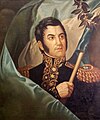|
Pedro Medrano Pedro de Medrano y Cabrera[1] (26 April 1769 – 3 November 1840) was a Uruguayan-born Argentine statesman, poet and lawyer. He was a provisional president and a representative to the Congress of Tucumán which on 9 July 1816 declared the Independence of Argentina.[1][2] Medrano was born in San Fernando de Maldonado in Uruguay. He studied in Buenos Aires and at the Colegio Montserrat de Córdoba and gained his doctorate in law at the University of Charcas, becoming known as a brilliant orator.[2] In 1810 he was appointed an oidor of the Real Audiencia. That same year he participated in the May Revolution at the Cabildo Abierto. He was one of the authors of the 1815 provisional statute of Argentina.[2] He was elected by Buenos Aires to the Tucumán Congress in 1816 for the declaration, serving as the first president of the Congress and giving the inaugural speech.[2] Medrano was secretary of the provincial junta of representatives in 1821 and a deputy on two occasions. He served as fiscal (state attorney) from 1838 and president of the Chamber of Appeals. He was a friend and ally of Juan Manuel de Rosas.[2] FamilyPaternal ancestryPedro de Medrano was the son of Don Pedro de Medrano de la Plaza, born in Navarrete, La Rioja, Spain.[2] His father married Victoriana Ana de Cabrera Saabedra on June 29, 1764, in Buenos Aires, part of the Gobernación del Río de la Plata within the Spanish Empire. Victoriana Ana de Cabrera Saabedra was baptized on January 15, 1744, in Buenos Aires.[1] His father was born in 1728 in the Parroquia Santa María de la Asunción, Navarrete, La Rioja, Spain. His father died on 20 February 1795 in Buenos Aires, Argentina. His mother was born in 1723, in Navarrete, La Rioja.[3] His paternal grandfather Pedro de Medrano y Corral,[4] born in 1709 in Navarrete, La Rioja, Spain, was the husband of María de la Plaza Otárola, born in March 1704, also in Navarrete.[5] Maternal ancestryHis maternal grandparents were Lucas de la Plata (born in Otálora de la Plaza in October 1667, Navarrete, La Rioja,) and Doña Ana de Marcos Mayoral Ruiz de Villalba, born in March 1670, in Navarrete, La Rioja, Spain.[5] BiographyPedro de Medrano y Cabrera was born on April 26, 1769, on Gorriti Island in San Fernando de Maldonado, Uruguay.[6] His birth occurred while his father, Pedro de Medrano y de la Plaza, was temporarily stationed there by Governor Francisco de Paula Bucareli. His father was a Treasury official in Buenos Aires. Pedro returned to Buenos Aires to begin his early education and later continued his studies at the Colegio de Monserrat in Córdoba, which he entered in 1781. He pursued higher education at the University of Chuquisaca, graduating on May 2, 1789, with degrees in Canon Law and Civil Law.[2] Political careerDuring the May Revolution of 1810, Medrano was an active supporter of the patriotic cause. On June 15, 1810, he was appointed as the auditor of the War Council. Shortly after, on June 23, he became a judge of the Audiencia, and on June 27, he was named a judge of assets and deceased estates. He was also nominated for the position of prosecutor of the Audiencia of Charcas but declined. Medrano's political career advanced when he was elected deputy for Buenos Aires to the Assembly of the Year XIII on October 3, 1812.[2] Attempted restoration of the Spanish MonarchyIn 1814, he was part of a diplomatic mission led by Manuel Belgrano to Spain for the restoration of King Ferdinand VII. In April 1815, he joined the Junta de Observación, contributing to the drafting of the Provisional Statute.[2] President of the Congress in TucumánOn August 22, 1815, Medrano was elected as a national deputy for the National Congress in Tucumán. He served as the provisional president from March 24 to May 2, 1816, delivered the inaugural address, and administered the oath to other congressmen. He was recognized for his oratory skills and involvement in various committees. His term as a deputy ended when the Congress moved to Buenos Aires in 1817.[2] SenatorIn 1819, Medrano was proclaimed elected senator under the new Constitution, but political turmoil prevented him from taking office. By 1821, he was elected as a representative to the provincial Legislature, serving as secretary and later re-elected as deputy in several terms until his death. In 1829, he was appointed to the consultative Senate by General Viamonte but resigned due to disagreements over the institution's political direction.[2] Judicial careerIn 1831, Medrano was named a chamber judge and later became the president of the Appeals Court on June 28 of the same year. In 1833, he joined a board of theologians, canons, and jurists created by the government for ecclesiastical advice. He was appointed state prosecutor in 1838.[2] PoetAside from his legal and political achievements, Medrano was also noted for his contributions to poetry and oratory. His works include the political romance "Carta de Celio a Armesto," which criticized unitarians and the December 1, 1828, revolution. He also authored "La Martiniana" and an introduction to "Poema y la gloriosa Expedición a los Desiertos del Sud" in 1833 and 1834, though the latter remained incomplete.[2] IdeologyPolitically, he was a supporter of the Federalist Party and a personal friend of Juan Manuel de Rosas.[2] Death and legacyPedro Medrano passed away on November 3, 1840. His funeral took place on November 25 at the Cathedral, led by his brother, Bishop Mariano de Medrano. In recognition of his friendship, Rosas decreed the construction of a monument in his honor at the Cementerio del Norte. Unfortunately, due to a lack of resources, the monument was never constructed.[2] References
References |





